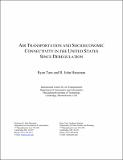| dc.contributor.author | Tam, Ryan | |
| dc.contributor.author | Hansman, R. J. | |
| dc.date.accessioned | 2007-02-07T21:54:12Z | |
| dc.date.available | 2007-02-07T21:54:12Z | |
| dc.date.issued | 2003-07 | |
| dc.identifier.uri | http://hdl.handle.net/1721.1/35886 | |
| dc.description.abstract | In light of ongoing threats to the viability of traditional airline business models and the provision of air service in the United States, this paper studies the fundamental interdependence of the national economy and the air transportation system. A conceptual framework has been developed to identify the mechanisms that enable air transportation to shape regional economic productivity and social connectivity. Regional economic census data is combined with airline traffic and financial data to illustrate the changes in supply and demand for air travel after the deregulation of the airline industry in 1978. The paper focuses on how the utilization of air transportation system supports economic and social activities across greater distances than would otherwise be possible—changing the economic geography of market access. An analysis of industry restructuring after the economic bubble and the attacks of September 11, 2001 are also used to look at the potential impacts on economic activity at the regional and national levels. | en |
| dc.subject | national economy | en |
| dc.subject | air transportation | en |
| dc.subject | deregulation | en |
| dc.subject | productivity | en |
| dc.subject | connectivity | en |
| dc.title | Air Transportation And Socioeconomic Connectivity In The United States Since Deregulation | en |
| dc.type | Technical Report | en |
| dc.identifier.citation | Aviation Management Education and Research Conference ( AMERC), Montreal, July 2003. | en |
